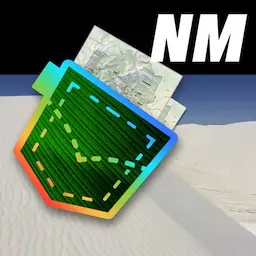"Sandstone Bluffs Overlook" by NPS/Maci MacPherson , public domain
CavingEl Malpais |
featured in
| National Parks Pocket Maps |  | |
| New Mexico Pocket Maps |  |
El Malpais
National Park Service
U.S. Department of the Interior
El Malpais National Monument
Caving
Underneath the lava flows of El Malpais lie a hidden world of lava
tube caves. With a free caving permit and proper equipment, you can
explore fascinating geology and hidden ice formations.
Caving Permits
Cave Safely
Cave Softly
Permits are required and available at the El
Malpais Visitor Center, Information Center
(seasonally), and the El Morro Visitor
Center. Permits are free, and visitors must
speak with a park ranger about cave safety,
conservation information, and their level of
caving experience. Cave permits are only valid for
indicated times and specific caves. Talk with a park
ranger and visit the park website to learn more:
www.nps.gov/elma
Don’t Go Alone - Group exploration makes
caving safer. Keep together, warn others
about hazards or fragile formations, and
always tell someone where you are going and
when you will return.
Lots of Lights - Each caver should carry
three light sources and extra batteries.
Prevent Exposure & Injury - Dress
appropriately for caves. Ambient
temperatures in most caves is around 42
degrees (6 degrees celsius) year-round, some
are colder. Wear long sleeves, long pants,
boots, and gloves. Cave ceilings are sharp,
use helmets to protect yourself.
Know Your Limits - Injuries and
disorientation are more common when you
are tired. Always choose a cave that is easy
enough for the least experienced member
of your group. Caves are not safe for small
children and service animals due to the
rugged nature of the terrain.
Leave No Trace - Do not eat, drink, smoke,
litter, or leave human waste inside caves.
Many cave formations are delicate and can
easily break - do not touch them.
Cultural Artifacts - Do not touch or
disturb cultural artifacts such as pottery,
arrowheads, or animal bones.
Respect Bats - Observe closures to protect
bats while they are hibernating or raising
EXPERIENCE YOUR AMERICA™
Be Observant - Pay attention to your route
and remember junctions and landmarks.
their young. If you do see a bat, stop talking,
keep your light pointed away, leave the area
as quietly as possible, and report the sighting
to a ranger. This will help protect these
important animals.
Prohibited - Campfires, smoking, camping,
pets, and candles are not allowed in caves.
These activites along with vandalism,
including marking or defacing cave features,
is illegal and punishable by law.
Bats & White-Nose
Syndrome
At least 14 bat species are found in the
monument. Many depend on lava tubes
for shelter, reproduction, or hibernation.
Bat Cave is home to a summer colony of ~
40,000 Brazilian free-tailed bats, the only
colony of its kind for hundreds of miles.
Bats are a critical part of our environment
and provide great economic benefits. Many
eat insects, including agricultural pests,
saving American farmers millions of dollars
in pesticides and crop damage annually.
Fruit-eating bats pollinate the plants that
provide us with cashews, bananas, coconuts,
avocados, or tequila.
a disease known as White-Nose Syndrome
that has killed over 6 million bats in the U.S.
and Canada. To prevent the spread of this
disease, all visitors requesting cave permits
are screened for factors that make them a
high risk for introducing the disease from
their footwear or equipment.
To learn more about bats, visit a Western
National Parks Association park store at
a visitor center, or visit Bat Conservation
International’s website: www.BatCon.org
Bats are in peril from a European fungus,
Pseudogymnoascus destructans that causes
EXPERIENCE YOUR AMERICA™
August 2015


